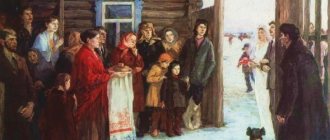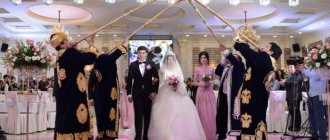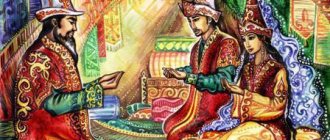In the high mountainous regions of the Central Caucasus live an original and interesting people who call themselves Taulula, and are known to us as Balkars. The traditions of the Balkars have long been preserved by new generations. And today in many villages of this area you can notice ancient rites and rituals.
The history and origin of the Balkar people are still shrouded in a fog of mystery, but culture helps to find the answer to many questions. What are the traditions of the Balkars? What is the family structure and customs of this people?
Matchmaking
It all starts with the groom's relatives helping him find a girl who will suit him as a bride. Next, the groom and his closest relatives head to the girl’s house, hoping that her father will agree to marry off his daughter. If the answer is positive, they begin to discuss the topic regarding the bride price. We must immediately warn you that the groom was not always lucky to receive a blessing from his future father-in-law the first time. Often he sent the annoying guy away with nothing.
The goal could be achieved after the second, third, etc. approach Apparently, in this way the firmness of intentions was tested. This is exactly how a Kabardian wedding begins, in Nalchik for example.
After the families agreed on the bride price, they moved on to the next stage - bridesmaids. The ritual of exchanging wedding rings was not delayed for long. As soon as the groom paid part of the previously agreed upon amount of dowry, he was given the opportunity to take his beloved out of her parents’ house.
From that moment on, the bride and groom were settled in different houses. According to tradition, the future husband and relatives should not contact for some time. The rule was especially harsh in relation to the bride, groom and elders. Only after a long period of time was it possible to bring the beloved to the yearning guy. First of all, the girl examined the room where the young people would soon live. The common room was allowed to be seen after a few weeks. Kabardian weddings are about observing all traditions and rituals.
Such a superficial description is not able to reflect the spectacular rituals of the Kabardian wedding, of which in reality there are many. Unfortunately, with each new generation, traditions and rituals are gradually forgotten and lose their original content. Although modern Kabardian weddings often feature national costumes and spirited dance elements, not all indigenous residents like this. What makes them angry?
Bride
After paying a certain part of the bride price, the groom received permission to take the bride out of the parental home. According to tradition, the young were settled in different houses. From that moment on, communication between the groom and the bride, as well as with relatives, ceased. Enough time passed before the groom was allowed to see the bride: she was brought to the house where she would soon live with her husband.
First of all, the future wife inspected the room in which, after the wedding, the new family was to live. The bride was not allowed to visit the common room for several days. These traditions and rituals were very strictly observed in the past. Today, even the most beautiful Kabardian wedding includes only some components of folk culture. Traditions and customs are gradually being forgotten; they are no longer given the same importance as before.
Modern traditions of Kabardian weddings
In the scenarios of modern Kabardian weddings, the kidnapping of the bride is considered a mandatory ritual. Relatives received the girl in their house. The parents who came to the chosen one asked her whether she agreed. This did not happen in ancient times. If the answer was yes, then from that moment on the young couple was considered husband and wife. The marriage was necessarily registered by a Muslim priest, an imam, invited to the house.
A beautiful Kabardian wedding, like all other holidays, is celebrated at home. Local residents cannot imagine that it could be organized in some cafe or restaurant. This is explained by the fact that if the girl refuses, she should be able to freely return to her home. This option was not provided in previous years. As soon as the marriage is concluded in compliance with all Muslim traditions, the newlyweds begin to prepare for an exciting celebration.
It is generally accepted that after the bride and groom spent their first wedding night, the sheet on which they slept together must be taken out of the house as material evidence. Despite the fact that Islam has a negative attitude towards this ritual, many Caucasians continue to adhere to it.
According to tradition, representatives of opposite sexes are required to celebrate Kabardian weddings separately. Oddly enough, guests should not see the bride.
Marriage in the face of Allah and official civil registration
After the Imam enters into a marriage according to the laws of the Islamic religion, preparations begin for the official part of the celebration. After the first wedding night, it is customary for guests to show the sheet on which the newlyweds spent their night. Although this contradicts modern moral and ethical principles. The first two days of pre-wedding preparations, the groom's family continuously celebrates the upcoming event. On the third day, they are joined by the bride's relatives, who brought a dowry: jewelry, clothes, household items and money. They slaughter a ram and take out the best wine from the cellars. The parents of the newlyweds are not present at the official wedding in a state institution. After receiving the marriage certificate, everyone goes to the groom’s house, where the banquet itself is planned. Only the male relatives from both sides sit at the table. They congratulate the newly-made husband, introduce him to the elders, and will definitely try to turn off the lights and steal the groom’s headdress. The young man’s task is to prevent them from doing this and leave the room with his friends. When the bride is introduced to the groom's family, a lamb skin is brought to the center of the hall. Having placed the girl on top of her, everyone is trying to sharply pull the skin from under her feet. The bride’s task is to hold on and not fall. Then dancing, showering the bride with millet and small money.
According to etiquette at Kabardian weddings, men and women must have fun separately from each other, and the bride must be hidden from the eyes of strangers under a veil.
How do modern European traditions influence the celebration of a Kabardian wedding?
Modern European trends penetrate the traditions of all peoples living outside Europe. Every year, national rituals are forgotten and identity is lost. Nowadays, not a single wedding is complete without an expensive car; everyone present tries to dress in the latest fashion. And, of course, the solemn event must be filmed on video and recorded on a digital storage medium. Special Kabardian toasts are also prepared for the wedding.
The opinions of the indigenous people are divided into opposites: some approve of the innovations, others remain adherents of the traditions of their ancestors.
Ultimately, the right to choose how to celebrate the wedding is given to the relatives of the newlyweds. In any case, Kabardian weddings are fun and spectacular.
Traditions and customs of Kabardian wedding
One of the small nationalities of the Middle East, living in the foothills of the Caucasus, are the Kabardians. Due to their isolated location and free spirit, they try to preserve their culture, and a Kabardian wedding is a clear demonstration of their customs.
The roots of the traditions according to which the holiday takes place, as well as the rituals preceding it, according to various sources, go back to 2-4 thousand BC. e. Such ancient origins make the whole celebration very unusual and original, which is ideal for newlyweds who want to have a unique wedding.
How does matchmaking and engagement work?
Kabardians are a rather leisurely people, especially in such an important matter as choosing a bride. It is believed that a young man cannot adequately assess how good a woman will be for him as a wife. Therefore, relatives take a closer look at available girls, drawing conclusions about how well they are brought up.
This is a rather slow method, but it allows you to collect all the information about a potential relative. Thanks to this, even a small stain on the girl’s reputation will be noticed, which will worsen her chances of a good marriage. When a guy expresses a desire to marry a girl, and if the elders of the family have no objections, then matchmakers are sent to the bride’s parents.
Among the delegation there must be an eldest man in the family who talks about his desire to become related. Parents can immediately refuse the groom, or take time to think about the proposal. Sometimes the reflection period reaches 4–5 months. After this, a second meeting takes place, where the decision is announced.
Wedding preparations
The first custom, which already applies to organizing a wedding, is the placement of the bride and groom in different houses. But for this, the girl first needs to leave her father’s house.
This ritual is called “coming off the pillow.” To carry it out, a huge embroidered pillow is used, on which the newlywed stands, and friends and relatives are placed around her.
The older men of the receiving clan must buy the bride. Most often, only part of the agreed upon price is paid for the girl. After the girl has been ransomed, she is brought to the groom so that he can take her out of her father’s house. At the same time, the woman must confidently cross the threshold with her right foot, this means that the path to a new family will be easy and problem-free.
If the bride stumbles, then this is regarded as a bad sign. This tradition arose due to the fact that previously the ashes of ancestors were buried under the threshold so that they would protect the family from bad people. The procession takes the bride first to the prepared rooms, and then the groom, while they live in different houses. After this, the man has no right to contact his relatives for 3-4 weeks. In some villages the same prohibition applies to women, but it is rarely used.
Young people devote this time to moral preparation for future marriage.
Unusual traditions of the Balkars
In the old days, the Balkars worshiped fire. The fire of the home was especially valued. It was impossible to rekindle an extinguished fire using coals taken from neighbors. To do this, each family had one specific day when they could “share” the fire with neighbors or take coals for themselves.
No less interesting is the custom of kunakism, which the Balkars adhere to to this day. Kunakism is also called artificial kinship, which, in my opinion, is very accurate. Such a connection can be established by very close and trusted people, true friends who want to link the destinies of their families together.
To carry out the ritual of kunakship, time-tested friendship was required, as well as a special ritual. During it, both people poured a drink into a cup and, taking turns making an oath to each other, drank it.
At the end of the ceremony, friends exchanged weapons and presented each other with gifts. The one who committed kunakship was considered equal to a blood relative. He had to support his comrade in any situation, and if necessary, even give his life for a friend.
Balkar dance
Celebration
Modern weddings take place only by mutual consent, although previously a man could steal the girl he liked. If she was not returned before nightfall, then the parents had to give consent to the marriage, otherwise their daughter would be covered in shame because she spent the night not in her own home.
Now marriage consists of several stages:
- Blessing by the imam, who conducts the ceremony in accordance with Muslim traditions. After this, the marriage is considered concluded, and the girl is taken to the groom’s room, which is where they will live. The next day the marriage is declared confirmed, and sometimes a bloody sheet is shown. But the last point of the custom is performed extremely rarely.
- After this, the man’s parents celebrate a successful wedding, say toasts, dance, sing songs, express many deep sayings in their language, while simultaneously preparing for the official celebration. On the third day, they are joined by the bride's relatives, who bring with them her dowry.
- When everything is ready, the newlyweds officially register the marriage. However, their parents are not present at this part of the wedding.
- After receiving official confirmation, the newlyweds move to the groom's house, where the main celebration will take place.
There are several mandatory traditions that are strictly observed at every wedding:
- The groom is seated at a table with men of both clans, who communicate with him, and is introduced to the elders. After that, they turn off the lights and try to steal his headdress. The young man must show all his dexterity to prevent this.
- Before the beautiful bride enters the hall, a ram skin is spread on the floor. The girl stands on the sheepskin, and her relatives try to pull the skin from under her feet. The newlywed must maintain balance; it is good if she does not sway too much. It is absolutely unacceptable to fall.
When all the tests have been passed, the newlyweds dance, and relatives shower them with coins and millet, wishing them well-being and prosperity.
According to tradition, if men who are not relatives of the bride or groom are present at a wedding, the girl’s face should be covered with an opaque cloth, men and women celebrate in separate rooms without intersecting.
Similarities and differences between wedding ceremonies among the peoples of Kabardino-Balkaria
Similarities and differences between wedding ceremonies among the peoples of Kabardino-Balkaria
Introduction
Among the many rituals of the peoples of Kabardino-Balkaria, there is none more colorful and exciting than the wedding. Having studied the works: “Russian and Ukrainian population of Kabardino-Balkaria”, “New and traditional in the culture and life of Kabardians and Balkars”, “Terek Cossacks”, as well as visiting the museums of Art. Alexandrovskaya, st. Kotlyarevskaya, Nalchik Museum of Local Lore, we identified the importance of rituals for the population of the peoples of the Kabardino-Balkarian Republic and the similarities and differences in wedding rituals among the peoples of the North Caucasus.
In my work: “Similarities and differences in wedding rites among the peoples of Kabardino-Balkaria,” many examples are presented that reveal the theme of the project.
Goals:
• revival of folk culture;
• study the wedding traditions of the peoples of Kabardino-Balkaria;
• educating youth on national traditions;
• familiarization with the customs, shrines and ideals of the peoples of Kabardino-Balkaria;
• identify the similarities and differences between the wedding ceremonies of the peoples of Kabardino-Balkaria;
• present tests and game situations for a better understanding and memorization of the traditions and customs of the peoples of the CBD.
Main part
The choice of a bride among the peoples of Kabardino-Balkaria was almost the same. This is evidenced by numerous facts.
Terek Cossacks married from the age of 17-19. The qualities of the bride were judged by her parents. It is important that she comes from a decent, economic family and is accustomed to careful housekeeping. Previously, the choice of the bride was entirely handled by the groom's parents, but from the middle of the 19th century. The main role is increasingly given to the groom himself.
In the villages, young boys and girls communicated with each other quite freely. In spring and summer they gathered on the street, in the steppe, in the pasture (from Easter), in the forest (from Trinity). A small group of young people of the same age was usually called a herd.
They sang, danced, and played various games. In winter, boys and girls, starting from the age of 14, gathered for gatherings, parties or after-school events. To do this, each herd rented some kind of hut, most often from a single woman. At such parties, girls did work - sewing, spinning, knitting. But they also had time to have fun with the guys - songs and games continued until late at night. This is where all those gathered usually had dinner and spent the night. Parties or celebrations took place without the participation and control of adults, but young people did not abuse their freedom. As one of the residents of the station wrote. Cool, “despite the fact that girls and boys spent whole nights together, modesty and decency were strictly observed in their relations”
In pre-revolutionary times, Cossacks married at a fairly early age. Girls got married at the age of 16, but most often at 17-18 years old. A girl over 20 years old in many villages was already considered an old maid (in the village of Ekaterinogradskaya they were called peredoyki). Only a widower with children could marry her.
Cossacks usually married at the age of 18, but occasionally even at the age of 17, in order to quickly bring a worker into the house. Usually, at the age of 21, when a Cossack entered military service, he was already married. Those who have not married for a long time, in Art. Cool was called Kabardian couples - Kabardians, unlike the Cossacks, got married late.
Choosing the bride and groom.
When deciding who to marry their son or who to give their daughter to, parents consulted with their relatives, but the final word remained with the father. He could tell his daughter: “It’s not for whom you want, but for whom I will give it.” Of course, not all fathers and especially mothers (if the father was not alive) gave their daughters in marriage by force. In the 1920s, more often, although not always, parents began to take into account the wishes of their children when entering into marriage.
Even if a Cossack girl didn’t like the groom her parents wanted to marry her to, she very rarely decided to go against their will. In this case, she could have been kidnapped by the person she wanted to marry. It even happened that the bride was kidnapped right during the wedding, almost from the church steps. After this, her parents had to come to terms with her choice and agree to the marriage. But such cases were the exception. Much more often the girl obeyed the will of her parents. Kabardian and Balkar youth had the same exceptions to the rule when the groom kidnapped (kidnapped) the bride.
Here is how Khan-Girey describes a Kabardian wedding: “Young Circassians, having a free relationship with the girls, have the opportunity to please each other and make their feelings clear. After such an explanation, the man asks the chosen girl to be his wife from her parents through their attorneys. If the parents agree, he gives the girl’s father or brother a gift, which corresponds to a betrothal or an agreement. After this ritual, the chosen girl belongs to her groom (that is, others should not seek her hand in marriage). Then they make conditions about the time of payment of the ransom or the agreed portion. The brother or closest relative of the person entering into marriage with numerous friends, invited for this occasion, comes to the bride’s house, where they spend several days before the transaction of the relative payment of the ransom, and the invited friends of the groom, each pay something to him. Nowadays there are no daring and cheerful jokes to which those who come for the bride would not be subjected. Every night, young people gather in the house where the guests are located, and spend the whole night in noise, games and pranks until light. (This is reminiscent of the pre-wedding ceremony of the Cossack youth.) All good clothes are removed from the guests, usually giving them the most worn ones in return, why do those who come the bride is often dressed in bad and worn-out clothes).
The wedding rituals of the Kabardian and Balkar peoples are very similar. The relatively free upbringing of girls, the opportunity for young people to communicate at various amusements, festivals, dances, and competitions contributed to
freedom of choice of bride and groom among Balkar youth. Having secured the girl’s consent, the groom, through his relatives, informed his parents about his choice of bride.
In many cases, parents found a bride for their son through relatives, acquaintances, etc., made inquiries about her parents, property status, her upbringing, abilities, etc. If the information received satisfied their interests, they informed their son about it, which undoubtedly took into account the choice of the parents. The young man used any means to achieve a meeting with her, to get to know her. Often he went with his friends to the village where she lived, and saw the girl at a friend’s or relative’s place, that is, a bride-show was arranged.
From the examples considered, we see that the young people of Kabardino-Balkaria communicated freely and could choose a bride to their liking, but the last word remained with the parents.
The pre-wedding rites of the Terek Cossacks were somewhat different from the pre-wedding rites of the mountain people, but for all of them the young people organized games and entertainment in the bride’s house
A traditional Cossack wedding can be divided into two main stages. The first of them consisted of pre-wedding, preparatory rituals, the second - the wedding itself. In turn, the pre-wedding cycle is divided into several ritual complexes. The first of them includes matchmaking, collusion, inspection of the groom’s household, etc. The Kabardian and Balkar peoples had the same ritual. The content of this ritual complex was the achievement of an agreement between the relatives of the bride and groom about the upcoming marriage and the conditions for its conclusion. Matchmaking was the first ritual of the pre-wedding cycle among all the peoples of the North Caucasus. Those who matched the girl were called matchmakers in most villages. Matchmakers were chosen by the groom's parents, usually from among their relatives. Most often, girls sent 2-3 matchmakers to their parents, among them were both men and women.
Matchmakers, as a rule, were elderly, experienced people, they had to be married, and precisely in their first marriage - “first destiny”. Widows, widowers, and after their appearance, divorced people, were never entrusted with matchmaking.
Obviously, there was an idea that the future fate of the young people depended on the choice of matchmakers. Arriving at the girl’s parents, the matchmakers started an allegorical conversation. According to informants, in almost all villages this conversation began with the question: “Do you have a heifer for sale?”
At the end of the 19th and beginning of the 20th centuries. neither in Art. Cool, not in st. The Ekaterinogradskaya girl’s parents did not immediately consent to the marriage. Even if they liked the groom, they delayed the final answer for several days or weeks. The matchmakers came to them for the second and third time.
This ritual is similar to matchmaking among the Balkar people. (Having chosen a bride for their son, the parents began matchmaking (kelechile). The groom’s closest relatives, and sometimes including the maternal uncle, etc., went to the parents of the chosen girl. Custom did not allow the parents and the bride’s relatives who had gathered for this occasion to immediately give satisfactory answer.)
When a preliminary agreement on the wedding was reached, the bride and groom were asked for consent to the marriage. As a rule, they gave such consent regardless of how they actually felt about the upcoming marriage. In the village of Prokhladnaya and Priblizhnaya, the girl answered her parents: “I won’t leave with your will.”
Inspection of the groom's household. This ritual was practiced by all the peoples of the Caucasus and had different names. For the Cossacks it looked like this. After the matchmaking, the bride’s relatives went or drove to the groom to look at the stove, that is, to inspect the house, yard, and household of the family to which they were going to give their daughter. This custom had practical significance only when the bride and groom lived in different villages and the bride’s parents did not know his property status. But in this case, the groom could deceive them - instead of his yard, show them the farm of a rich neighbor. If the bride and groom lived in the same village (which happened more often), then her parents, of course, knew how wealthy their future relatives were, but the custom was observed in this case, although the relatives of the bride and groom did not so much inspect the household as continue to celebrate matchmaking.
Masonry. Typically, during matchmaking, the parents of the bride and groom agreed on the costs of the wedding. In Art. Ekaterinogradskaya at the beginning of the 20th century. the groom had to pay the bride’s parents “the agreed amount of money, from 10 to 200 rubles, depending on the condition. Sometimes, instead of money (or together with it), the groom gives one or more horses, bulls, cows, rams, or a certain amount of wheat, flour, millet, and sometimes he gives a grove, a garden, etc.” (This is reminiscent of the dowry paid by the groom of the mountain people.)
This is the only mention that the bride’s parents could receive cattle, a grove or a garden as a wedding ransom. Typically, the groom's contribution consisted of money, food, clothing or household items needed for the dowry. For example, in Art. Cool, the bride's parents received from the groom's parents "an allowance in money, vodka, wine, flour and various products from the household." All these supplies were intended for the wedding. According to informants, in a later period in all villages, including the village of Yekaterinogradskaya, the groom most often paid the bride's parents from 10 to 50 rubles. Sometimes he bought the bride a wedding dress, shoes or the missing part of the dowry - a blanket, shawl, skirt, etc. In the village of Priblizhnaya, this contribution was called masonry - as in many regions of Russia. However, in the same village another name is recorded - kalym. But unlike the bride price, known to many peoples of the Caucasus, the masonry in the Cossack villages did not remain with the bride’s parents, but was spent by them on the wedding or on the dowry.
Conspiracy at the end of the 19th - beginning of the 20th century. was also carried out in Art. Cool, and in st. Ekaterinogradskaya. The conspiracy was perhaps the main rite of the pre-wedding cycle. It was during the conspiracy that the bride and groom were brought together here, and the final agreement on the wedding was concluded. On the day of the conspiracy, a solemn procession with songs went from the groom's house to the bride's house. The bride's relatives seated those who came to the table and treated them. Then one of the girls brought the bride into the room, who brought the groom a glass of vodka and a glass of wine and asked him to taste it. The groom drank and kissed the bride. At this time, the girls sang: “And how about you, Nastasyushka, aren’t you ashamed to kiss someone else’s baby...”
Then the bride brought wine and vodka to her relatives and the groom’s relatives, and the girls sang a song:
Drunkard is a drunkard, Father Katenkin, Drunkard is a drunkard, Katya’s mother. Oh, they drank Katenka for honey, for vodka, etc.
This was where the vaults ended, but the conspiracy continued; the relatives of the bride and groom began to lay down their hands, sealing the marriage contract. The girl's parents gave consent to the marriage several times - first to the matchmakers, then to the groom's parents during the matchmaking, and finally, the final consent during the matchmaking. How was consent or refusal to marry expressed? In all the villages, matchmakers, going to the girl’s house, took bread and vodka or wine with them. If the girl’s parents did not want to marry her off, then they returned their bread and drink to the matchmakers - this meant refusal.
This is what refusal or consent to marriage looked like among the Balkar people. Visits and negotiations were repeated 2 times. If the girl’s paternal aunt touched the hearth tripod with her hand, this meant that the parents should consult with relatives. Clean cast iron placed at the hearth meant that they could not answer anything yet, a full bucket of water gave hope of not agreeing, spoons on a wooden tray indicated that they were not ready for an answer, a cup in a frying pan indicated that there would be an answer soon, but a skewer in a vertical position they said that the answer would be negative.
During matchmaking, after the bride and groom agreed to the marriage, one of those present, most often the bride, usually cut the bread brought by the matchmakers into 4 pieces and gave them to the parents of the bride and groom. From the moment the girl cut the bread, she was considered match-made in all villages. This custom has been preserved among the Cossacks to this day. In all three rituals that sealed the marriage contract, bread played an important role. Obviously, they were based on the idea that a joint meal united people, created
close, even family, connections between them.
In the old days, Terek Cossacks played weddings as a theatrical spectacle. As part of the wedding ceremony, songs occupy the most important place: they belong to the ceremony and are performed outside the ceremony. Their function is ritual; they give publicity to the beginning, progress and weddings as an everyday legal act. This is the difference between the wedding ceremony of the Terek Cossacks and the peoples of the Caucasus. Gatherings and parties. After matchmaking, and in Art. In Ekaterinogradskaya, after the conspiracy, her friends gathered in the bride’s house almost every day, helped her sew and embroider her dowry, as well as gifts for the groom and his relatives - scarves, pouches, pockets for the mother-in-law. These were get-togethers. In addition to them, parties were held - young people gathered in the bride's house and spent time singing, dancing, and playing games.
For Kabardians, a wedding, like receiving a guest, is the affair of the entire family. It is still customary in many Kabardian families to pay bride price for the bride. All relatives take part in collecting this bride price. The dowry must include furniture, bedding, dishes, and various things intended for the groom's relatives in the form of gifts. A poor dowry is considered a shame not only for the bride, but also for all her loved ones.
And this is what a modern Kabardian wedding looks like through the eyes if the groom stole the bride.
From the very morning there is music in the Karmokovs' house. Today is the first day of Alim and Zarina's wedding. Although without their participation. In the evening, the relatives of the future daughter-in-law should arrive to meet the relatives and arrange the wedding. All expenses for the organization are borne by the groom's relatives. The bride's parents have a dowry. By the way, it turns out to be more expensive than the wedding itself. After all, a young woman needs to be provided with everything - from cosmetics to a fur coat. Moreover, everything should be just new. Larisa Adamovna has not seen her son for 15 days. This is exactly how much time has passed since Alim kidnapped the bride. Until he is forgiven by his family for entering adulthood without the permission of his elders, he cannot appear in front of his parents. All this time she is hiding with friends, and in the meantime Larisa Adamovna is preparing to meet her daughter-in-law. While waiting for guests, national dishes are prepared.
No wedding would be complete without “khazhanyshe” - beef in its own juice. By the way, only men cook meat dishes. But the sweet table is already a woman’s responsibility. There must be delicacies, sherbet and sweets on the table. And, of course, pasta - this is the name of the national bread. Kabardians say that they owe their health and slimness to her.
Towards evening, relatives from the bride’s side arrived at the Karmokovs’ house. Women and men, strictly according to age, were seated in different rooms, where relatives got to know each other. Although, dating is a formality. After all, in a small village everyone knows each other. A messenger from the bride and groom assures the couple's consent to the marriage in front of the mula. This is where the ceremony begins. It is interesting that neither the groom, nor the bride, much less the parents, participate in the marriage. Only the elders of the clan.
“Does your family give away the girl?” - the mula’s question sounds. And in response we hear - “gives.” Each party must answer this question three times. After the mula separates the fingers of the elders, the marriage is considered concluded. Not at the moment
registration in the registry office, and now the young people have become husband and wife. The bride and groom appear in their future home only on the second day of the wedding. The young woman meets all her relatives and receives instructions from her elders. It is interesting that the bride meets her mother-in-law last in the rite of binding and ransom.
After meeting, the bride is usually taken away from home. Now it's the groom's turn. He appears surrounded by bodyguards, always with his head covered; according to custom, the father hands him a tray with various goodies and speaks instructions to his son. After which Alim must run out of the house, holding his hat on his head. According to Kabardian customs, a wedding is, first of all, a holiday for relatives and guests.
2-3 days before the Cossack wedding, a new stage of pre-wedding rituals began, directly related to preparations for the wedding. Some rituals of this stage were performed in all villages on the territory of Kabardino-Balkaria - this was the making and decoration of a loaf, a visit to the cemetery by an orphan bride, a bachelorette party. A day or two before the wedding, wedding ritual bread - loaf - was baked in all villages. In addition, in all the villages they prepared small buns for the wedding - cones, without which not a single Cossack wedding can take place even now. The loaf was decorated with cones and birds made of dough, viburnum, but its main decoration was a branch. The loaf was decorated by girls - the bride's friends. They accompanied their work with songs. This is what they sang in st. Alexandrovskaya: And the viburnum-raspberry stood on half a mountain, But it didn’t bloom much, There were only two colors: Scarlet and white. Scarlet - Ivanushka, Belenky - Marusenka, stood at the end of the table, holding a charm in her hands: - My dear father, Please eat the charm, listen to my speeches. Don’t give me away, I’m young, I’ll sit for a year, I’ll bring you scarlet ribbons.
After all the pre-wedding and preparatory rituals were completed, the wedding ritual itself began. Most informants consider the first day of the wedding to be the day on which the wedding took place. We usually got married in church on Sunday. A traditional Cossack wedding lasted at least three days.
At first, the groom followed the bride, they went together to church, and from there to the groom’s house. At the end of the 19th century in our village, when the bride was brought to the groom’s house, the wedding train entered the yard “through a fire,” according to local residents, “from witchcraft.” The groom's parents met the newlyweds at the door of the house with bread and salt and blessed them with an icon. Immediately the bride and groom were showered with hops, money, and sweets. In the ritual of the Kabardian people, the daughter-in-law was sprinkled with crackers at the entrance to the groom's house.
The groom's wedding clothes were a Cossack military uniform - a beshmet, a Circassian coat, and a belt with a dagger. As you know, this clothing was borrowed from the Kabardians. There is no information about how the bride dressed in any description of the wedding of the late 19th - early 20th centuries. But from the stories of informants it is known that already in pre-revolutionary years, the bride’s outfit consisted of a long white or light dress and a veil. The wedding dress was credited with magical powers and was kept for a lifetime. If a child was sick, they covered him with a wedding dress, he was supposed to recover. On her wedding day, the bride had one braid, and the hair in front was curled (plotted). A veil and a white wax wreath were put on top. Soon after arrival or after dinner and gifts, the bride left the table and in another room, with the help of an older groomsman, changed into a regular suit and put on a scarf. The change in clothing emphasized the change in her social status. The Kabardian bride also changed her hat to a scarf after the wedding.
The bride and groom received their parental blessing on their wedding day. If one of them did not have parents, then he went to the cemetery the day before or on the first day of the wedding. The bride and groomsmen knelt down. The girls sang: Yes, it is not the bay leaf that spreads along the ground, It is not Olyushka who bends to the ground.
The arrival of the groom for the bride in all villages took place approximately the same. The groom was accompanied by a wedding train - a phaeton, several carriages, and in winter - a sleigh in which his retinue was accommodated - a friend, a matchmaker, boyars, etc. Having arrived at the bride's house, they stopped in front of a closed gate, which was guarded by the bride's relatives, armed with sticks and stakes , and sometimes with guns. Those who arrived were allowed into the yard only after they gave a ransom - vodka if adults were at the gate, or money if the gate was guarded by teenagers. In Art. Ekaterinogradskaya greeted visitors with the song: Unexpected guests. Why did you come? As if we were waiting for you, Yes, the carpets were laid out.
Glorious and reproachful songs were sung by the groomsmen and relatives of the bride during the wedding. In majestic songs, the girls played up the bride and groom, the best man, and other guests and received money for it. In reproachful songs, the guests were ridiculed, most often by the friend and the matchmaker. In Art. Alexandrovskaya sang: And the matchmaker is a fool, she didn’t wash her shirt, She was in a hurry to the wedding, she didn’t wash her shirt.
These songs were one of the manifestations of ritual hostility between the bride and groom's side.
Bride ransom. When the groom and his retinue entered the bride's house, she sat at the table in the front corner. Sitting next to her was her younger brother, less often the bride’s sister or several children. They were armed with rolling pins and demanded a ransom - they “sold” the bride. The girls sang:
Bargain, bargain, brother, don’t sell your sister cheap, ask for a hundred rubles for her, for her braid, a thousand. For the mind, for the mind - there is no count.
After this, the wedding dinner began. The groomsmen escorted the bride to the groom's house, but from there they, as a rule, soon left. Apart from the senior groomsman and the best man, only adult married men and married women remained at the wedding. This showed that the bride and groom were moving from a group of youth to a group of married adults.
The bride's departure from home. When the bride left or left her yard, she
accompanied by song. One of the versions of this song is recorded in Art. Approximate
Mashenka was leaving the yard,
Oh, I broke the birch tree from the top,
Oh grow, grow, birch tree, without top,
Live, live, dear father, without me...
In the wedding ceremonies of the peoples of the Kabardino-Balkarian Republic, customs borrowed from each other echoed each other, as, for example, at a Cossack wedding there were horseback riding, shots were heard and the “Lezginka” was danced with pleasure. A very interesting fact is that the wedding of Kabardians living in Mozdok is different from the wedding of Kabardians living in the KBR.
“The wedding of the Mozdok Kabardians had a distinctly festive character. She was beautiful - with dances, songs, horse riding. The appearance of newlyweds at a wedding was strictly regulated by special ceremonies. The wedding included the following structure: matchmaking, marriage registration, bringing the bride, removing the veil (khyteh), returning the young man to his home, bringing the bride into the “big house”. It should be noted that the Mozdok Kabardians, unlike the Kabardians of Kabarda, did not preserve such elements of the wedding as an inspection of the house, a trip for the bride price, the escape of the old woman, the groom's grandmother and others. But on the other hand, the wedding ceremony of the Mozdok Kabardians included some elements that they adopted from the Ossetians and Georgian settlers. For example, the presentation of gifts by all those invited at the wedding table, the bride’s farewell to her parents’ home, etc. “” This suggests that cultures living nearby tend to penetrate each other.
What is common in wedding ceremonies among the peoples of Kabardino-Balkaria:
• matchmaking of the bride;
• sprinkling the bride upon entering the groom's house;
• horse riding, shots during a wedding;
• conversion of the bride from a girl to an adult woman;
• theft of the bride, if the parents did not consent to the wedding;
• after matchmaking - inspection of the groom's yard;
• after the matchmaking, there are parties for young people in the bride's house.
Differences in wedding rituals among the peoples of Kabardino-Balkaria:
• payment of kalym only among the mountain people;
• Among the mountain people, the bride and groom are not present at the wedding;
• wedding in a church - a ritual unique to Cossacks;
• ritual songs were performed only at Cossack weddings.
Conclusion
There is no people without traditions. And the task of each generation is to preserve and increase everything achieved by our grandfathers and fathers. Therefore, I created the website “Centuries-old traditions of the peoples of Kabardino-Balkaria” in order to know more about the traditions of the peoples of the Caucasus and present this information in a colorful form for a large audience.
Bibliography
1., etc., “New and traditional in the culture and life of Kabardians and Balkars”, Elbrus publishing house, Nalchik, 1986
2. “Traditional culture of Kabardians and Balkars,” publishing house, 2008.
3. 'Traditional hospitality of Kabardians and Balkars', publishing house "Elbrus", Nalchik, 1990.
4. “Russian and Ukrainian population of Kabardino-Balkaria”, publishing center “EL-FA”, 2000. 5. L. B. Zasedateleva “Terek Cossacks”, M.: publishing house, Moscow State University 1974.
Get text
After the wedding
After the wedding, there is one interesting custom - it is called “elopement of the old lady.” The groom's grandmother leaves home, and the newlyweds must find her and bring her back. This shows their respect for their elders, and also that the old are always welcome under the shelter of the young.
All actions towards a woman should express maximum respect and care.
In this video there is a very beautiful Kabardian wedding:
Organizing a wedding in accordance with Kabardian traditions is a long and labor-intensive task. But thanks to measured preparation, the whole action looks solemn and impressive. Would you be able to show as much endurance as the Kabardian youth, waiting for all the rituals to be observed?
Kabardian wedding - Traditions and customs. Kabardino-Balkaria: religion, history and interesting facts
A Kabardian wedding is a joyful and spectacular event. Due to the fervor of the Kabardians themselves, disputes often break out at celebrations, developing into competitions, and sometimes even into very real conflicts. And all because traditional Kabardian matchmaking can last for more than one year, and all this time the passions around the future newlyweds are heating up and heating up. The groom's relatives, long before he decides to get married, look for a worthy girl for him. After that, commissioners were sent to the family of the prospective bride with a marriage proposal. If consent was obtained from the bride’s relatives, and according to customs this could take several months, the two clans began to conduct leisurely negotiations on the amount of bride price.
Traditional milestones of Kabardian matchmaking
The main feature of Kabardians is their thoroughness and slowness. Therefore, they did not come to a common decision regarding marriage soon. At the next stage, the bride’s ritual viewing takes place, and if everything went smoothly, they begin to plan the engagement. Matchmaking among Kabardians is carried out strictly in accordance with centuries-old traditions and is always carried out according to the same well-established scenario. At some point, the groom gives the girl’s relatives a pre-agreed part of the bride price, and with their consent can now take the bride beyond the threshold of her house. This action also takes place strictly according to protocol. Matchmaking is no less spectacular and eventful than the wedding itself.
The Kabardian wedding ceremony requires that the bride and groom live in different houses. Until the very day of the celebration, the young man cannot see his relatives, elders, and especially his bride. Only after a long period of time spent alone and thinking about her future life, the bride was brought to the house of her future husband, where she was accommodated in a room reserved for their life together. She was only allowed to go into the common room after several weeks, or even months.
Wedding traditions of the Balkar people
The wedding traditions of the Balkars are no less interesting. In former times, marriages often took place by agreement between the parents of two families, but since the beginning of the last century everything has changed somewhat - now the initiative comes from the groom.
The most respected elderly people were chosen as matchmakers. They find out whether the bride will agree to marry their relative. Often this decision did not belong to the girl at all, but to her family. Their word was law for her.
An important role in preparation for the wedding was played by the bride price, the bride price, which was paid in money and valuables. with a cat. In case of divorce due to the fault of the spouse, part of the bride price was credited to the woman’s account. Often the amount of bride price exceeded the capabilities of the groom's family, and then the men were forced to kidnap their brides. After this, the groom himself determined the size of the bride price, which he was obliged to give to the girl’s relatives.
Balkar wedding / gorets-media.ru
Wedding ceremonies of Kabardino-Balkaria
In rural areas, Balkars still observe ancient wedding rituals. If the bride lives in the same settlement as the groom, she must walk to his house, accompanied by friends and relatives. The groom himself does not participate in this procession.
An obligatory part of the bride's image is a white dress, which is considered a symbol of youth and beauty. The responsibility of the groom's friends was to ransom the bride during the wedding. After this, the groom could take his beloved in his arms, bringing her to the threshold of his house, after which he placed her on the cart.
Wedding in Kabardino-Balkaria
Weddings of Balkars are noisy and cheerful holidays. One of the ancient entertainment games was called “Bridegroom’s Cup.” Beer was poured into a large bowl (often as large as a bucket) to the brim, and the vessel itself was generously lubricated on the outside with oil. The groom's friends passed the slippery cup to each other. You had to drink all the beer without spilling a drop. Of course, only a few managed to do this, and the one who was at fault had to fulfill the wishes of the guests.
The traditions of the Balkars from ancient times to this day have not changed much. Some aspects became less significant, attitudes softened, but for the most part the rituals remained the same. Modern Balkars are similar to their ancestors. They remain the same proud, bright, original people with a rich culture that they carefully preserve.
On the cover: State Folklore and Ethnographic Dance Ensemble “Balkaria” / @EBalkaria / twitter.com
Modern interpretation of Kabardian customs
Nowadays, few Kabardians adhere to all procedures and rituals. Life in big cities can speed up and simplify everything. Modern traditions of Kabardian weddings come down to only the most widespread and popular elements of cultural heritage: singing, music, national costumes and hearty parting words. Most of all, the respected elders are outraged by the fact that now, before entering into a marriage, it is necessary to obtain the consent of the girl herself, and not just her parents. She is still taken from under her parents' roof and placed in the house of her closest relatives, but only if the intended bride herself agrees to the marriage - the Imam comes and formalizes the marriage. And if earlier the celebration necessarily took place in the house, now it is increasingly celebrated in a restaurant.
If a girl does not want to marry this particular man, she can simply turn around and go back home to her parents. Previously, as traditions said, the groom and his close friends could simply steal the woman they liked, after which she, strictly speaking, had no choice at all. Now such an act can be regarded as an attack on human life and freedom.
Kabardian principles
Of course, the modern life of the Kabardian people has been significantly influenced by urbanization processes, but this does not mean that ancient customs have faded into the background.
The residents of Kabardino-Balkaria have unshakable family principles that have remained virtually unchanged over the centuries. To a large extent, this is facilitated by the observance of Adyghe Khabze - a set of moral and ethical principles obligatory for every Kabardian. A significant role in it is given to the family structure.
Kabardian family postcard 1905
Just like for the distant ancestors of the Kabardians, family plays a vital role in the life of the modern people of Kabardino-Balkaria. All family members must treat each other with respect. Special honor is given to the older generation. The elder of the clan is equated to god. In his presence, younger family members do not have the right to speak first, much less interrupt during a conversation. At the table, the elder occupies the most honorable place.
On my own behalf, I would like to note that in many Kabardian villages today there are councils of elders - senior representatives of the village, who often have the last word in making important public decisions.
“Peoples of the Caucasus”, Russian lithograph, late 19th century
The family structure in Kabardino-Balkaria is patriarchal. But this does not mean that a woman has no rights. On the contrary, she is considered the true guardian of comfort and peace in the house, and she is treated with great respect.
Kabardians have a proverb: “The husband creates the wife, and the wife creates the husband . And these, it seems to me, are very accurate words. According to centuries-old principles, Kabardians believe that you can get married only once - this is the only way to preserve family values. For the younger generation, the family of parents is a role model.











